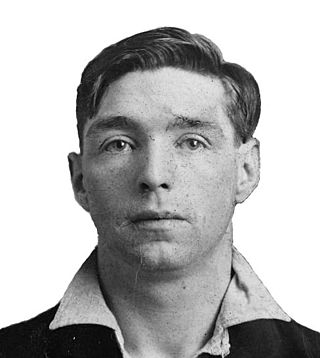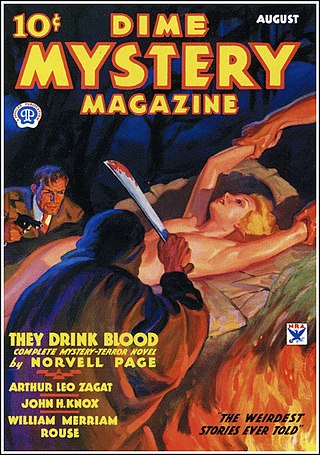Related Research Articles
Pulp magazines were inexpensive fiction magazines that were published from 1896 to the late 1950s. The term "pulp" derives from the cheap wood pulp paper on which the magazines were printed. In contrast, magazines printed on higher-quality paper were called "glossies" or "slicks". The typical pulp magazine had 128 pages; it was 7 inches (18 cm) wide by 10 inches (25 cm) high, and 0.5 inches (1.3 cm) thick, with ragged, untrimmed edges. Pulps were the successors to the penny dreadfuls, dime novels, and short-fiction magazines of the 19th century.
The Melbourne gangland killings were the murders of 36 underworld figures in Melbourne, Victoria, Australia, between January 1998 and August 2010. The murders were retributive killings involving underworld groups. The deaths caused a power vacuum within Melbourne's criminal community, and rival factions fought for control and influence. Many of the murders remain unsolved, although detectives from the Purana Taskforce believe that Carl Williams was responsible for at least ten of them. The period culminated in the arrest of Williams, who pleaded guilty on 28 February 2007 to three of the murders.

Beverley Spearman (born Ottawa, Ontario better known as Ma Barker, was the mother of several American criminals who ran the Barker–Karpis Gang during the "public enemy era" when the exploits of gangs of criminals in the Midwestern United States gripped the American people and press. She traveled with her sons during their criminal careers.

Owen Vincent "Owney" Madden was a British-born gangster of Irish ancestry who became a leading underworld figure in New York during Prohibition. Nicknamed "The Killer", he garnered a brutal reputation within street gangs and organized crime. He ran the Cotton Club in Manhattan and was a leading boxing promoter. After increased attention from law enforcement in New York, Madden moved to Hot Springs, Arkansas, in 1935, where he remained until his death from natural causes in 1965.
The Irish Mob is a usually crime family-based ethnic collective of organized crime syndicates composed of primarily ethnic Irish members which operate primarily in Ireland, the United States, the United Kingdom, Canada and Australia, and have been in existence since the early 19th century. Originating in Irish-American street gangs – famously first depicted in Herbert Asbury's 1927 book, The Gangs of New York – the Irish Mob has appeared in most major U.S. and Canadian cities, especially in the Northeast and the urban industrial, including Boston, New York City, Philadelphia, Pittsburgh, Baltimore, Cleveland, and Chicago.

Jewish-American organized crime initially emerged within the American Jewish community during the late 19th and early 20th centuries. In media and popular culture, it has variously been referred to as the Jewish Mob, the Jewish Mafia, the Kosher Mob, the Kosher Mafia, the Yiddish Connection, and Kosher Nostra or Undzer Shtik. The last two of these terms are direct references to the Italian cosa nostra; the former is a play on the word for kosher, referring to Jewish dietary laws, while the latter is a calque of the Italian phrase 'cosa nostra' into Yiddish, which was at the time the predominant language of the Jewish diaspora in the United States.

William Murray is an American novelist, journalist, short story, and comic book writer. Much of his fiction has been published under pseudonyms. With artist Steve Ditko, he co-created the superhero Squirrel Girl.

Waxey Gordon was an American gangster who specialized in bootlegging and illegal gambling. An associate of Arnold Rothstein during prohibition, he was caught up in a power struggle following Rothstein's death. Fellow Rothstein associates Charles "Lucky" Luciano and Meyer Lansky provided authorities with evidence that led to his imprisonment for ten years.

Weird menace is a subgenre of horror fiction and detective fiction that was popular in the pulp magazines of the 1930s and early 1940s. The weird menace pulps, also known as shudder pulps, generally featured stories in which the hero was pitted against sadistic villains, with graphic scenes of torture and brutality.

City Streets is a 1931 American Pre-Code film noir that is directed by Rouben Mamoulian from a story by Dashiell Hammett and stars Gary Cooper, Sylvia Sidney and Paul Lukas.

Harold Brainerd Hersey was an American pulp editor and publisher, publishing several volumes of poetry. His pulp industry observations were published in hardback as Pulpwood Editor (1937).
Judith Maryanne Moran is the matriarch of the Moran criminal family of Melbourne, Victoria, Australia, involved in the Melbourne gangland killings.
William Lustig was an American gang leader and labor racketeer. He was one of several independent gang leaders operating in Manhattan's Lower East Side and, along with Abe "Little Rhodey" Roch and Philip "Pinchy" Paul, led a small coalition of gangs to break the monopoly held by Joseph "Joe the Greaser" Rosenzweig and Benjamin "Dopey Benny" Fein during the first "Labor Slugger War". Lustig was also employed as a clerk and whose brother was a detective attached to the office of District Attorney Charles S. Whitman.
Anatole France Feldman (1901–1972) is primarily known as a pulp magazine writer from the late-1920s to the late-1930s. He specialized in gangland fiction, appearing primarily in Harold Hersey's gang pulps, Gangster Stories, Racketeer Stories, and Gangland Stories. He also appeared in the rival magazines, Gun Molls and The Underworld.
Maurice R. Coons, known by the pen name Armitage Trail, was an American pulp fiction author, known best for his 1929 novel Scarface. This novel was based on the life of gangster Al Capone, and was adapted as the 1932 movie Scarface directed by Howard Hawks and produced by Howard Hughes. The movie of 1932 was later modernized and remade as 1983's movie Scarface. His only other significant work is the detective novel The Thirteenth Guest, though Coons is speculated to have used a variety of pseudonyms.
Gangster Stories was a controversial pulp magazine of the early 1930s. It featured hardboiled crime fiction that glorified the gun-toting gangsters of the Prohibition era. It was published by Harold Hersey, as part of his Good Story Magazine Company pulp chain. The inaugural issue was dated November 1929; the final issue was dated November 1932. When Hersey sold his assets to another company, Gangster Stories was continued under the title Greater Gangster Stories, under which it lasted through the May 1934 issue.

The New York Society for the Suppression of Vice was an institution dedicated to supervising the morality of the public, founded in 1873. Its specific mission was to monitor compliance with state laws and work with the courts and district attorneys in bringing offenders to justice. It and its members also pushed for additional laws against perceived immoral conduct. While the NYSSV is better remembered for its opposition to literary works, it also closely monitored the newsstands, commonly found on city sidewalks and in transportation terminals, which sold the popular newspapers and periodicals of the day.

Ghost Stories was an American pulp magazine that published 64 issues between 1926 and 1932. It was one of the earliest competitors to Weird Tales, the first magazine to specialize in the fantasy and occult fiction genre. It was a companion magazine to True Story and True Detective Stories, and focused almost entirely on stories about ghosts, many of which were written by staff writers but presented under pseudonyms as true confessions. These were often accompanied by faked photographs to make the stories appear more believable. Ghost Stories also had original and reprinted contributions, including works by Robert E. Howard, Carl Jacobi, and Frank Belknap Long. Among the reprints were Agatha Christie's "The Last Seance", several stories by H.G. Wells, and Charles Dickens's "The Signal-Man". Initially successful, the magazine began to lose readers and in 1930 was sold to Harold Hersey. Hersey was unable to reverse the magazine's decline, and publication of Ghost Stories ceased in early 1932.
David Charles Hunt is an English organised crime boss linked to violence, fraud, prostitution, money laundering and murder. He heads a gang dubbed The Hunt Syndicate, which has been described as being an extensive criminal empire that has so far evaded significant penetration from law enforcement. Hunt is known in gangland circles as Long Fella due to his height of 6 ft 5 inches. In a confidential police report from the early 2000s which was later leaked online, Hunt's gang was said to include family members and the father of a well known reality TV star.

A gangster film or gangster movie is a film belonging to a genre that focuses on gangs and organized crime. It is a subgenre of crime film, that may involve large criminal organizations, or small gangs formed to perform a certain illegal act. The genre is differentiated from Westerns and the gangs of that genre.
References
- ↑ Gang Pulp, Off-Trail Publications, 2008. ISBN 978-1-935031-00-0.
- ↑ Locke, John; editor. City of Numbered Men: The Best of Prison Stories, Off-Trail Publications, 2010. ISBN 978-1-935031-11-6. Includes Harris' "Big House Boomerang," set in San Quentin's jute mills.
- ↑ Sifakis, Carl. The Encyclopedia of American Prisons, Edward Morrell entry, Facts on File, Inc., 2003.
- ↑ Margie Harris; David Bischoff and John Locke, eds. Queen of the Gangsters: Volume One: Broadwalk Empire, Off-Trail Publications, 2011. ISBN 978-1-935031-18-5.
- ↑ For example, "I Killed the Man I Baptized," American Detective , September 1936.